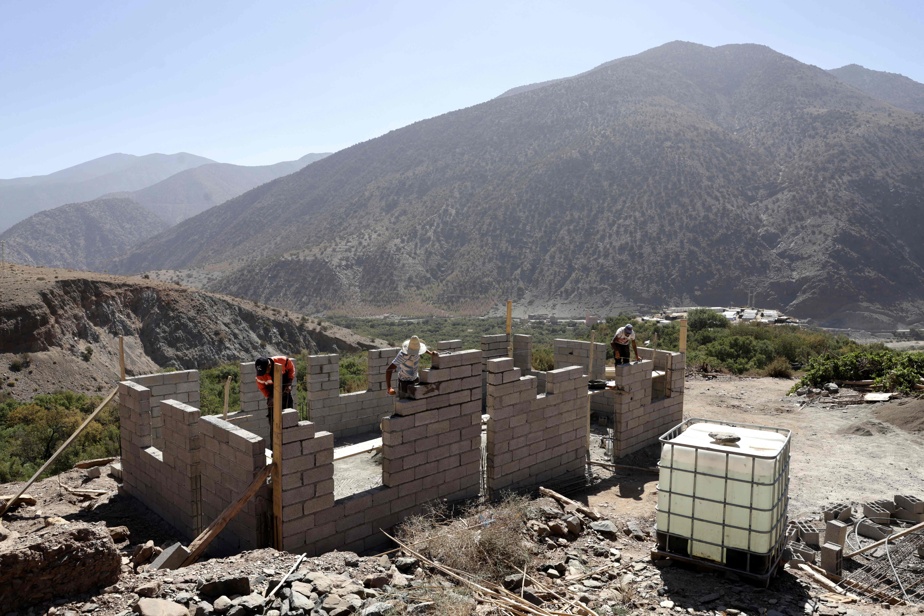(TINISKT) “I can still hear my grandson’s cries under the rubble.” A year after the powerful earthquake that struck southern Morocco, Kebira Aït Bellaïd is unable to mourn the loss of her daughter and three grandchildren.
“This earthquake changed me forever,” the 52-year-old woman, who still lives in a tent like most of the inhabitants of Tiniskt, perched in the mountains 70 kilometres southwest of Marrakech, told AFP.
This picturesque town, with its earthen buildings built in layers one above the other, was almost wiped out by the earthquake of September 8, 2023, which left nearly 3,000 dead and damaged around 60,000 homes in the High Atlas.
The trauma caused by the natural disaster, which claimed the lives of 45 people in Tiniskt, remains acute in this remote and difficult-to-access village of 500 inhabitants.

PHOTO AGENCE FRANCE-PRESSE
A woman walks among temporary housing structures in Tiniskt.
Kebira Aït Bellaïd is trying to move forward for her husband and her children who are “still alive”. But hearing “Rayan, 9 years old, who implores me under the rubble still haunts me”, says with emotion this woman who has since been followed by a psychiatrist.
Her neighbor Khadija Id Yassine hopes, with misty eyes, “never to think again about this nightmarish night although it remains anchored in [sa] memory “.
“Life is hard in the tent between the freezing cold of winter and the stifling heat of summer,” continues this mother of three children who has not yet been able to rebuild her house due to non-compliance of her land.
“Turn this painful page”
Although the majority of families in Tiniskt have received a first tranche of public aid (20,000 dirhams, or 2,780 dollars), only around ten reconstruction projects have recently been launched.
A slowness explained by the difficulty of accessing certain areas to carry out demolitions and clearing of rubble, indicates Amine Bouih, in charge of the province of Al-Haouz on which Tiniskt depends, within the public agency Al Omrane.

PHOTO AGENCE FRANCE-PRESSE
A man walks past temporary accommodation facilities in Tiniskt.
In this area, the most affected by the earthquake, 24,000 buildings are expected to be rebuilt. To date, 1,000 have been built, more than 9,000 foundations laid and about 5,000 structures constructed, according to Mr. Bouih.
In Ouirgane, a village on the edge of a national road 14 kilometers northeast of Tiniskt, the pace is faster: two houses are inhabited, others are under construction or being completed. All built in concrete, but with the obligation to make the facade coverings in earth.
Brahim Aït Ouarah is one of the lucky ones to have left the disaster victims’ camp in March to move into his new home, built at his own expense before receiving public aid.
“The six months I spent in a tent were very difficult, I was eager to turn this painful page even if nothing can compensate for the lives lost,” says this ambulance driver who lost his wife and a child in the earthquake.
The choice of concrete
In Tiniskt and other villages, the choice of reconstruction also fell on concrete, going against the recommendations of architects who advocated traditional construction in earth and stone.
“Concrete was imposed because people have preconceived ideas about traditional techniques, but that could have changed with awareness-raising,” regrets Yassine Aït Si Mhanned, a young man from Tiniskt.
For Mr. Bouih of the Al Omrane agency, traditional architecture presents “difficulties in the realization and in the duration of construction. It is more expensive in certain areas given the need for a qualified and very rare workforce.”
Architect Khalil Morad El Ghilali warns: “Introducing concrete in these regions is a big mistake, because it is expensive, not suitable for this environment and not reliable.”
According to him, “there has been a lot of pressure from the residents, the watchword is to satisfy them, which is not the right approach.” This professional is working on the reconstruction of 70 houses in earth or stone, after having discarded 280 projects based on concrete.
“The urgency of reconstruction has led to haste with a lack of vision around local constructive cultures and administrative blockages,” he laments.
